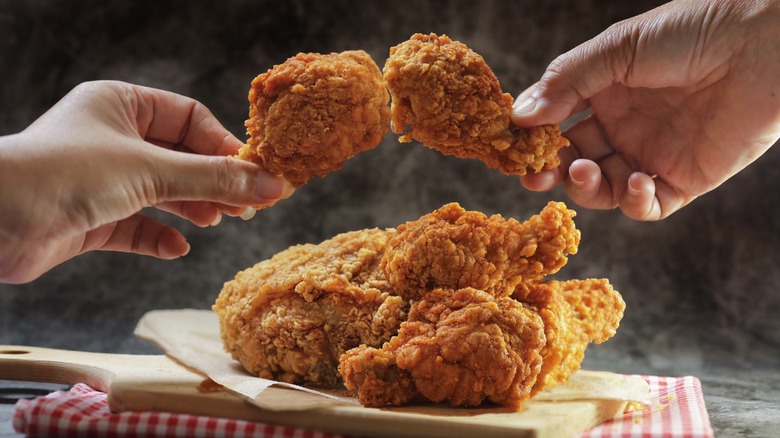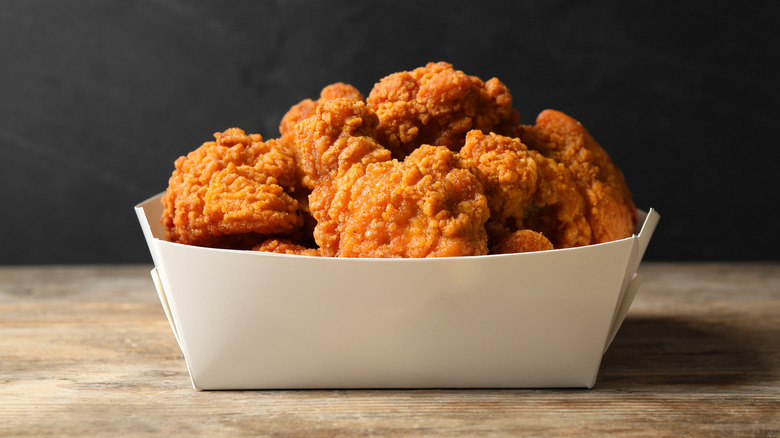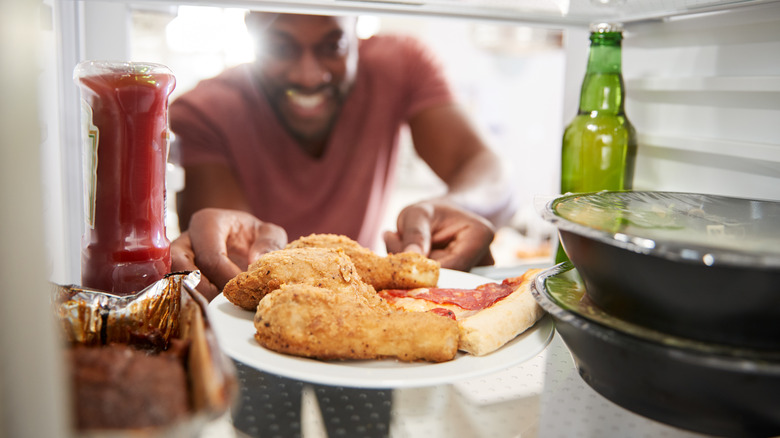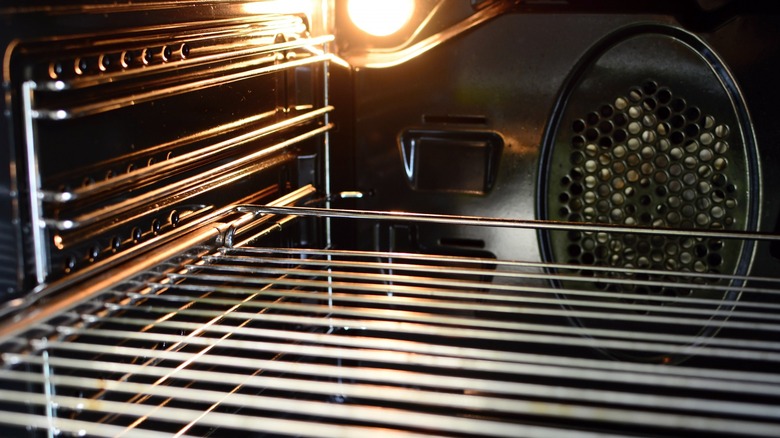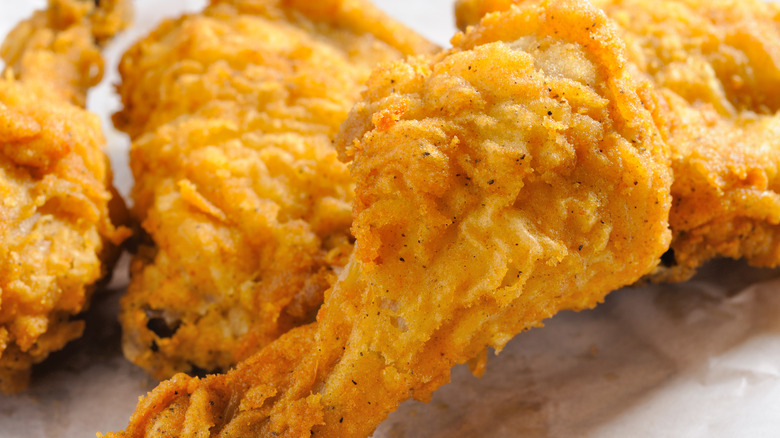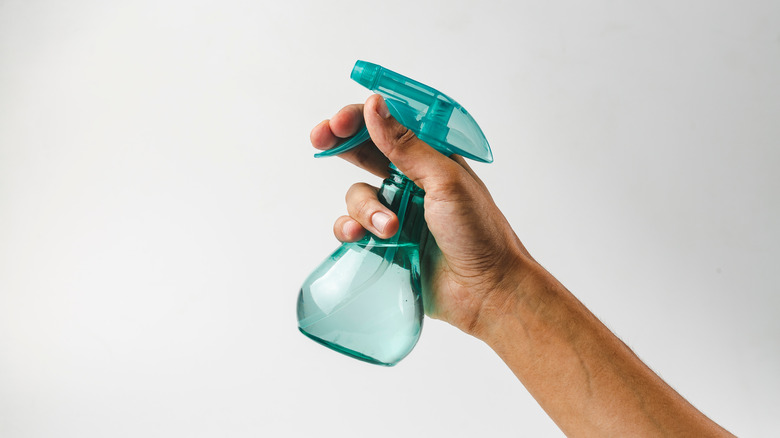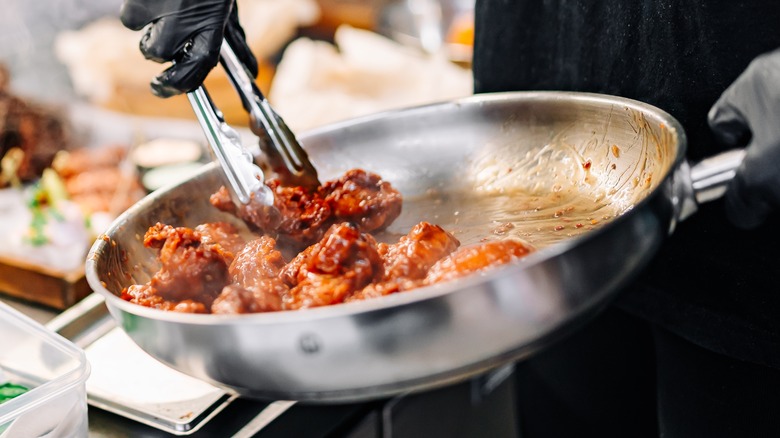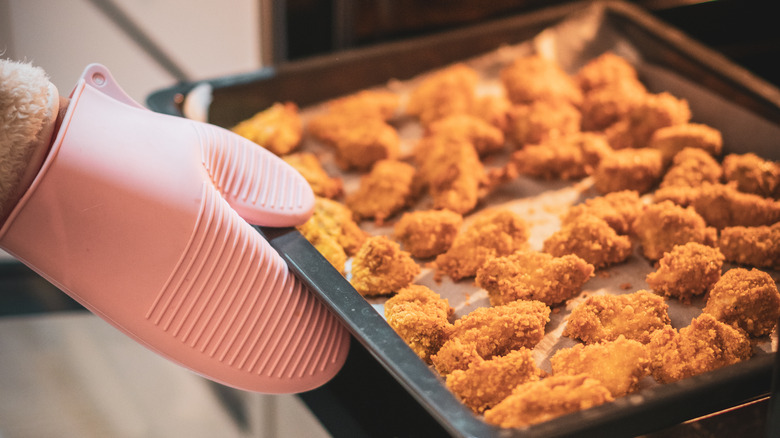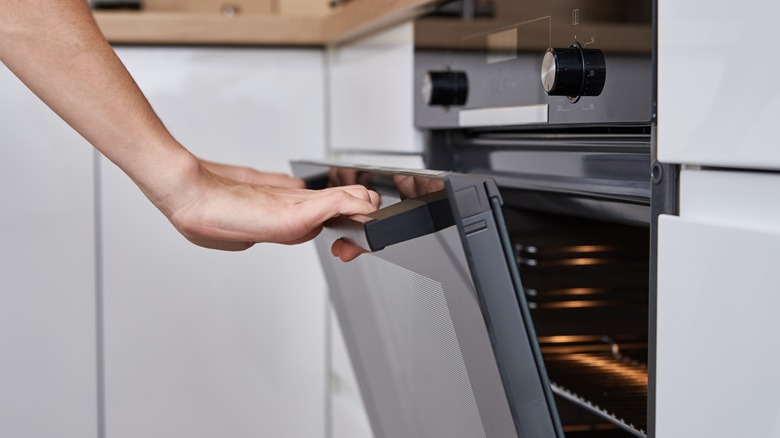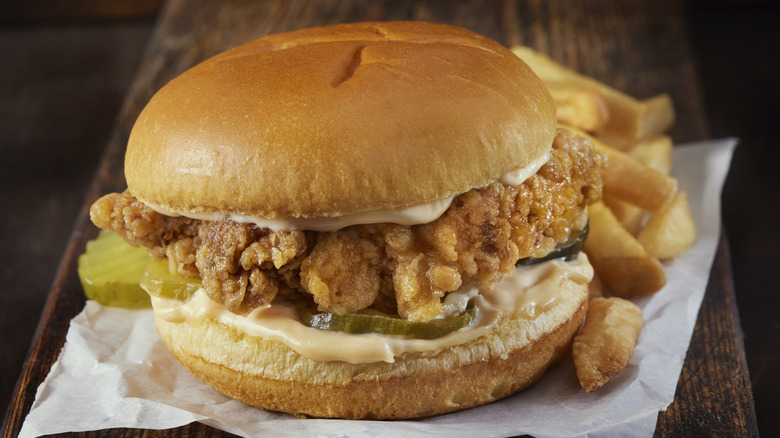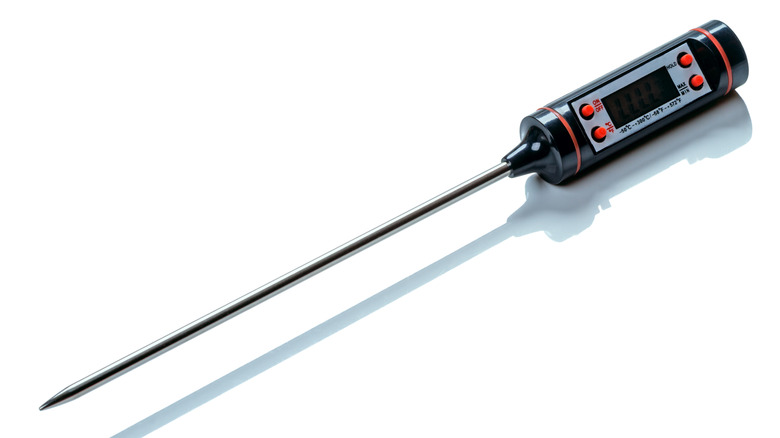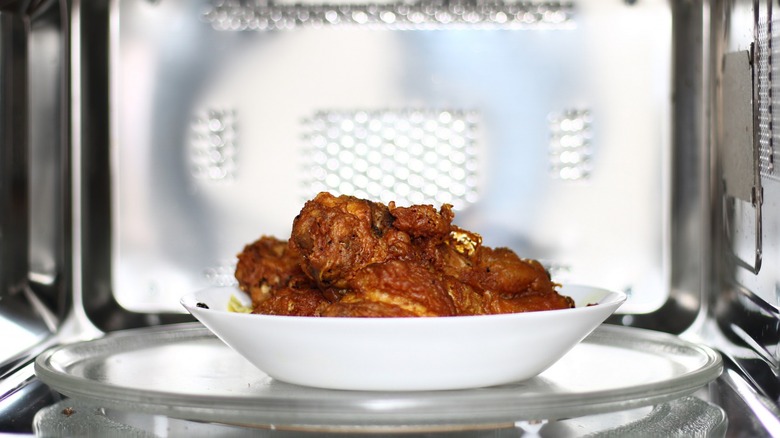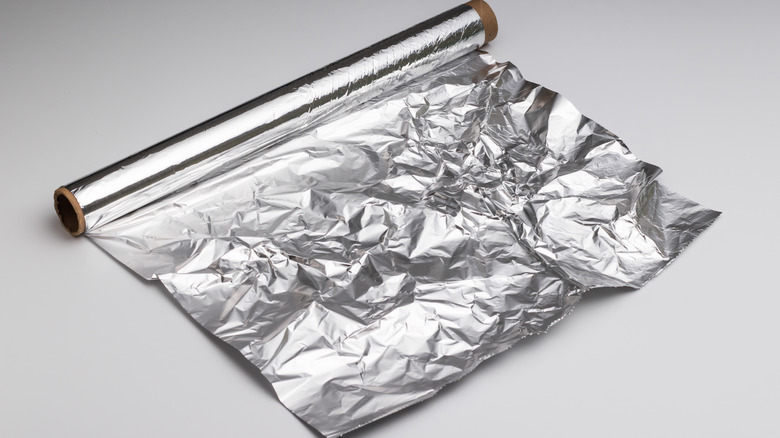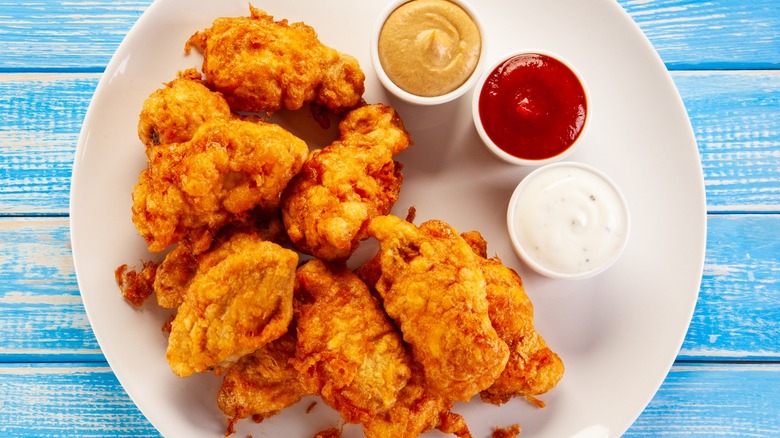14 Secrets For Reheating Fried Chicken
The act of coating chicken in a salty, spice-infused crumb and deep-frying it until it's golden and crunchy can take a meat that's traditionally minimal in flavor, and turn it into something that explodes with taste in your mouth. But leftover fried chicken is another matter. A large part of fried chicken's appeal comes from its crunch, but that crunch is lost as the chicken cools. The steam that's formed from the cooked meat, which escapes when you bite into a hot piece of chicken, begins to moisten the coating from the inside. This reduces its crunch and makes the chicken wet and dense.
However, when fried chicken is fully cool, it can become hard and chewy, with the coating ending up gluey and tasting like dough. So heating it back up to enjoy it is essential. But how do you do so in a way that brings the coating back to life, restoring its crunch without burning it?
In this article, we focused on secrets that preserve as much of the original crunch of the fried chicken as possible, while maintaining the meat's juiciness. We judged our secrets based on their ease of execution and ability to warm up the chicken with minimal fuss, and included methods for every major kitchen appliance, to ensure that anyone can take advantage of them.
1. Store your fried chicken in the right container
Reheating fried chicken well starts way before you plan on reheating it. If your fried chicken came from a restaurant or takeout place, it's likely that it was presented to you in a Styrofoam container. While Styrofoam is great for transporting food and keeping it warm, it also doesn't allow heat to escape. This means that any steam released from the chicken will go straight back into the fried chicken coating, moistening it, as well as collecting condensation inside the box.
The issue, though, is that fried chicken achieves its crispiness through what is essentially a dehydration process of the outside, caused by the hot oil it's cooked in. And if that coating rehydrates too much, it means that it makes it way harder to make it crunchy again. Luckily, you can avoid all of this by getting your fried chicken out of its Styrofoam container as quickly as possible, once you get home. Try storing it in a container that has some ventilation, or allow the food to completely cool without coverage before placing it in a sealed vessel and into the fridge. You should also try to keep it as loosely wrapped as possible, to avoid it collecting condensation around it.
2. Take your fried chicken out of the fridge in advance
Some fried chicken pieces can be pretty dense, and it makes warming them up a challenge. The breaded coating on the outside of the chicken will start to cook again, albeit gently, when it's warmed up, and the longer it takes for the heat to get to the center of your chicken, the more it'll go brown. In the worst-case scenario, your coating will burn before your chicken is warmed through. This is way more likely to happen if you're reheating fried chicken straight out of the fridge, as a cold interior will take longer to warm up. And, when you're having to blast it for longer to warm it through fully, you run the risk of the chicken drying out.
That's why you should always pull your chicken out of the fridge in advance, and allow it to come up to room temperature first. Take it out around 20-30 minutes before you're planning on reheating it, leaving it on the side until it warms slightly. Ensure that you're not leaving it out for too long, though. The longer that food sits at room temperature, the more likely it is to become hospitable to bacteria. Food should never sit out at room temperature for more than two hours.
3. In the oven, place it on a wire rack
When fried chicken is cooked, it receives heat from every side, thanks to the oil bath it's submerged in. But reheating it is another story, especially if you're doing so in the oven. The oven is an excellent choice to warm up fried chicken, thanks to its dry heat making the outside crispy while warming the meat through. However, your chicken will have to rest on something as it heats up, and if that surface is flat, it prevents the oven's heat from getting to it. This leaves one side of your chicken unable to crisp up, and it'll come out unevenly cooked.
To avoid this, place your chicken on a detachable wire rack over a baking sheet. That way, the oven's heat is able to circulate around the chicken pieces, warming and crisping them from every side. It also means that your chicken is less likely to stick to the surface of your baking sheet, which can often happen when placing it straight onto a flat surface in the oven. The baking sheet underneath, meanwhile, will help to catch any fat that drips from the chicken as it warms up.
4. Different cuts of chicken require different times
Anyone who's ordered a combination order of fried chicken will know that the pieces come in all different shapes and sizes. There's a significant size difference, for example, between a small chicken wing and a super-size breast. Trying to reheat them all using the same time and temperature, therefore, will result in completely different results — your smaller pieces will end up overcooked and tough, while your larger pieces will remain cool in the middle.
To avoid doing this, put your chicken in at different times. If you're using an oven, wings will usually take around 10-12 minutes to heat through, although larger ones may take a bit more time. Chicken breasts and thighs, meanwhile, may take around 15-20 minutes until they've fully warmed up. Bear in mind that bone-in chicken pieces may take slightly longer than boneless ones, as chicken bones absorb heat, and this can pull heat from the edible protein. Remember to check your chicken periodically while it's reheating to ensure that you're not inadvertently drying it out. It's also a good idea to heat up chicken pieces on separate baking sheets, to prevent having to pull your half-warm pieces out of the oven to add new ones, potentially dropping their temperature.
5. Spritz your pieces with water to keep them moist
Fried chicken relies on the balance of a crunchy coating with a moist inside to be successful, but when reheating it, this can be difficult to achieve. Either you heat it up too much, drying out your chicken, or you don't heat it up enough, leaving your exterior bready and soft.
A good way to tackle both of these things, though, is with a quick spritz of liquid. Spray your chicken pieces with some water or broth before placing them in the oven or air fryer to heat up. Spritzing them will give the chicken pieces additional moisture, which can help to prevent them from drying out as they reheat. However, the moisture can also help to make the outside of the chicken crispier as it evaporates from its outside, giving it extra crunch.
This trick is particularly useful if you're reheating larger pieces, which are more likely to dry out as they're coming back up to temperature. Using broth in place of water gives the chicken extra flavor, but be wary of using it if your breading is particularly well-flavored already, as you can risk making the chicken overly salty.
6. Chicken wings can be re-fried in a skillet
It's hard to go wrong with using an oven or an air fryer to reheat most types of fried chicken, but chicken wings are slightly different. Because they're smaller in size, they can also be easily reheated in a skillet or frying pan. This is a great method to imbue your chicken wings with additional crunch as you reheat them, and works well if you're short on oven space or are working with a basic kitchen setup.
To do this, add some oil to your frying pan, and then add your wings, frying them on one side for a few minutes before flipping and repeating. Bear in mind that this method causes you to essentially re-fry the chicken, so make sure that you're not using too much oil, otherwise, you'll end up making your meal too greasy. It's also important to keep a close eye on your wings, as they'll brown way quicker than if you were reheating them in the oven, and if you're not careful they can scorch or burn.
7. When reheating in the oven, use parchment paper
When you heat up fried chicken, the fat in the coating can drip down. And if you're reheating it in the oven, that fat will pool at the bottom of the chicken pieces and soften the breading, causing it to adhere to the baking sheet you're using. In the worst-case scenario, this will result in the coating all ripping off when you try to remove the chicken from the sheet, leaving half of your food stuck to the metal.
Preventing this by using a nonstick material like parchment paper is the best way to go. Parchment paper is designed to withstand heat of up to 450 degrees Fahrenheit and is totally oven-safe. After you remove your chicken from the oven, it'll slide straight off and will keep the bottom of the chicken crispy too.
Other nonstick materials might be less successful. While wax paper looks similar, it's not built to take the high heat of the oven and will catch fire if you use it. Coating your pans with foil, meanwhile, is not recommended, as the chicken can stick to it just as capably as it would to the sheet.
8. In a pinch, your broiler will work well
If your oven and your air fryer are both broken, your broiler can do the trick with your fried chicken. Broilers aren't typically used to reheat fried chicken, but the intense heat they can reach helps to warm it through while re-crisping your chicken effectively. As they tend to heat up quickly, they're also faster than using an oven.
Just remember that unlike ovens, microwaves, or air fryers, broilers don't operate by using wrap-around heat. Instead, they cast the heat directly downward onto the food you're cooking. This means that unevenly shaped pieces of chicken, like bulky thighs with extra-thick breading, may be less suited for broiler reheating. Instead, use your broiler for smaller, flatter pieces of chicken, like chicken tenders or chicken wings, and place your broiling rack low down to avoid the chicken coming into contact with the hot metal. Additionally, make sure to keep a close eye on your chicken, as broilers can burn food incredibly quickly, especially breaded items. Ensure that you flip your chicken halfway through broiling, too, to make sure it's getting an equal amount of heat on each side.
9. To reheat a fried chicken sandwich, you'll need to deconstruct it
A day-old chicken sandwich is usually pretty depressing, but it needn't be. You can reheat a leftover Chick-fil-A sandwich, or indeed any chicken sandwich you like, pretty easily — all it takes is a little deconstruction. Take the sandwich apart, place the chicken on one side, and remove any toppings from the bun. Then, microwave the chicken patty for up to 90 seconds, before throwing the bun in for just a few seconds (it'll heat up pretty fast, so make sure not to nuke it too much).
Once that's done, all you need to do is reconstruct the sandwich, and you're good to go. Bear in mind that microwaving the chicken patty is the quickest way of heating it up, but it might not be the best. If you want your patty to be as crispy as it can get, it might be best to put it in the oven or air fryer — but bear in mind that this will take slightly longer. As well as this, bear in mind that any sauces that were on the burger may have soaked into the patty or the bun, so ensure that you add more to make up for it and add additional moisture.
10. Your air fryer is your best friend
Your air fryer is excellent for reheating all kinds of food, but arguably the best thing to warm up in it is fried chicken. Air fryers can warm your chicken efficiently, giving you crispy fried chicken every time you reheat it thanks to the convection function in the appliance surrounding the food with hot air. This crisps the chicken from all sides, working its way through the slots in the bottom of the frying basket to heat the food's underside.
Because air fryers heat up almost instantly, they can be a much quicker option than using a conventional oven. And because the machines are smaller, they're way better for heating up individual portions of chicken. Most pieces can be reheated in as little as 3-4 minutes in an air fryer set to 375 degrees Fahrenheit. Ensure that you're flipping your chicken over halfway through the reheating process, so it gets heated evenly. If your fried chicken is particularly greasy or you're worried about the clean-up operation afterward, you can line the frying basket with parchment paper. Just bear in mind that this will prevent the hot air from circulating to its full potential, and may not produce the crispiest result.
11. To ensure it's safe to eat, check the temperature
Some people can get a bit squeamish about reheating fried foods, but the truth is that it's perfectly fine to warm up leftover fried chicken and eat it at another time. To ensure full food safety, though, it's vital that it's reached an internal temperature of 165 degrees Fahrenheit. This rule applies both when you're cooking chicken for the first time, and when you're reheating it. As fried chicken cools, it can drop into the "danger zone," the temperature range of 40-140 degrees Fahrenheit in which it's capable of growing bacteria. If you don't reheat your chicken to a minimum of 165 degrees internally, it can still harbor that bacteria when you eat it, as certain microbes may not be killed off.
To check this, it's useful to get yourself a probe thermometer. Stick it into the thickest part of your fried chicken pieces to check its temperature. Most pieces of fried chicken will reach this temperature after 10-20 minutes in a hot oven. Additionally, while it might be tempting to warm them up even more than this, remember that there's a thin line between chicken being hot and juicy, and becoming overcooked and stringy.
12. Use your microwave for quick results
Traditional wisdom dictates that reheating foods like french fries and fried chicken in the microwave will produce worse results than reheating them in an oven or air fryer. This is due to the fact that fried foods find it tough to get crispy when heated by microwave energy, as they essentially begin to steam, moistening the food.
However, it is entirely possible to reheat fried chicken in the microwave, and doing so will warm your food up very quickly — it just won't be as crispy as before. After taking your chicken out and leaving it at room temperature to warm up slightly, place it on a microwave-proof plate, and then blast it in the microwave in 30-second intervals. Ensure that you're flipping the chicken after each interval, to make sure it's being heated from all sides.
There are several tricks you can perform to keep your food as crispy as possible. One is to place some paper towel over your chicken, which will suck up some of the moisture and steam released by the chicken. You can also try placing a mug full of water in the microwave next to your food, which can help to absorb excess moisture.
13. To ensure your chicken stays juicy, wrap it up
Reheating meat in an oven or air fryer is an effective method, but if you're not careful, it can also ruin your food. As air fryers and ovens produce heat through circulating dry air, they can wick the moisture that works its way to the surface of the food away from it. This can dry out food items that you want to remain juicy, like fried chicken, and turn them tough and stringy.
But to reheat meat in the air fryer without drying it out, simply wrap it in some foil beforehand. The foil will trap any moisture that comes out of the chicken, with the steam it produces permeating back into the meat and keeping it tender. It will take a few extra minutes to warm up the chicken this way, as the heat will have to first permeate the foil, so make sure you give yourself some extra time. Remember, too, that this method is likely only desirable for certain types of fried chicken, like unbreaded buffalo wings which don't necessarily have to be crispy. For fried chicken with a crispy coating, it's way better to heat it without wrapping it up first, so the outside doesn't get damp.
14. Reheating fried chicken nuggets might require a slightly lower temperature
Chicken nuggets are little bite-sized pieces of joy, but they can be a nightmare to heat back up. Because they're so small, they have a knack for drying out very quickly, turning into hard, chewy bites instead of tender, juicy morsels. As such, they need to be treated differently from other types of fried chicken, which take longer to heat through.
The best way to reheat chicken nuggets, whether you're doing so in an air fryer or an oven, is to do so at a slightly lower temperature. While most fried chicken can be reheated at 375 or 400 degrees Fahrenheit heat, chicken nuggets should be reheated at 350 degrees. The lower temperature helps them heat through slowly, which stops them from hardening up too much. You can also heat up chicken nuggets under a broiler, but just make sure you're doing so at a low heat setting. It can also be a good idea to lightly spray chicken nuggets with cooking spray, to help them crisp slightly as they heat up, and to stop them sticking to your baking sheet.
